Watson, Frederick Stanley (Flight Lieutenant)
Killed in Action 1941-October-11
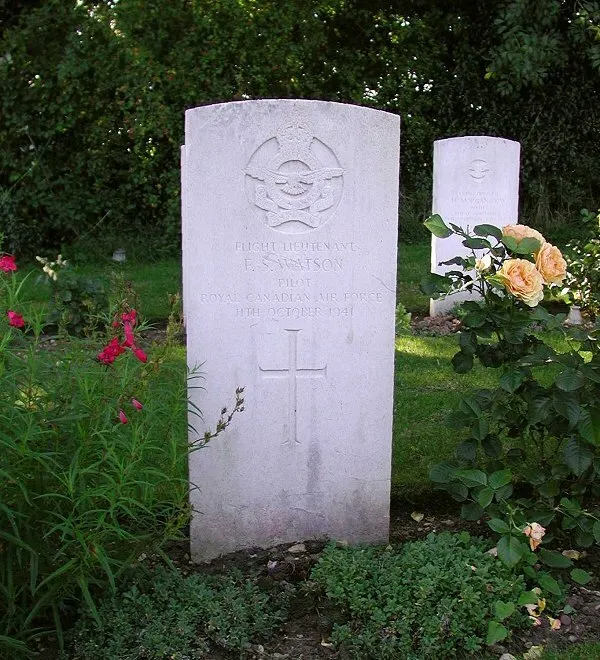

Birth Date: 1919
Born:
Parents:
Spouse:
Home: Winnipeg, Manitoba
Enlistment:
Enlistment Date: unkown date
Service
RCAF
Unit
409 Sqn- Squadron
Media Nox Meridies Noster Midnight is Our Noon
Base
Rank
Flight Lieutenant
Position
Pilot
Service Numbers
C/1372
Home
Defiant serial: AA281
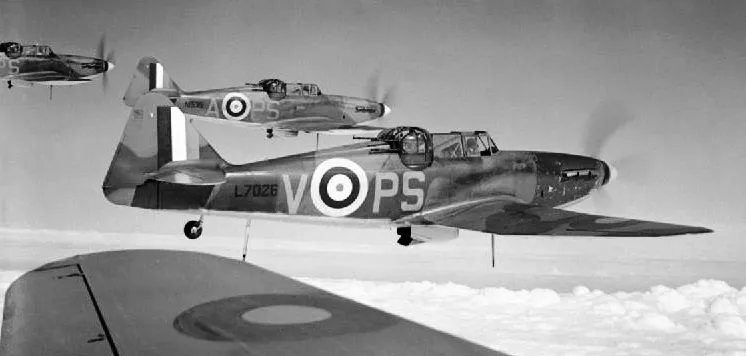
Boulton Paul P.82 Defiant, RAF (Serial No. L7026), coded PS*V, c1941.
The Boulton Paul Defiant is a British interceptor aircraft that served with the Royal Air Force (RAF) during World War II. The Defiant was designed and built by Boulton Paul Aircraft as a "turret fighter", without any fixed forward-firing guns, also found in the Blackburn Roc of the Royal Navy.
In combat, the Defiant was found to be reasonably effective at destroying bombers but was vulnerable to the Luftwaffe's more manoeuvrable, single-seat Messerschmitt Bf 109 fighters. The lack of forward-firing armament proved to be a great weakness in daylight combat and its potential was realised only when it was converted to a night fighter. It eventually equipped thirteen squadrons in this role, compared to just two squadrons as a day-fighter. In mid-1942 it was replaced by better performing night-fighters, the Bristol Beaufighter and de Havilland Mosquito.
The Defiant continued to find use in gunnery training, target towing, electronic countermeasures and air-sea rescue. Among RAF pilots it had the nickname "Daffy". Wikipedia
Unit Desciption
409 Sqn Media Nox Meridies Noster ("Nighthawk" )
History of the Squadron during World War II (Aircraft: Defiant I, Beaufighter IIF, VIF, Mosquito NF XIII)
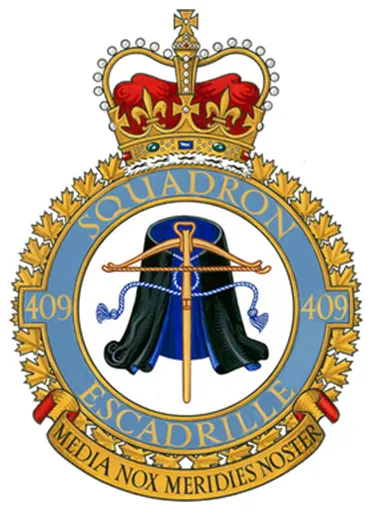
The squadron was formed at Digby, Licolnshire UK ![]() on June 17, 1941 as the RCAF’s 7th squadron formed overseas during WWII. It was designated as a night fighter unit and was originally equipped with Boulton Paul Defiant Mk. 1 aircraft. These were rapidly superseded in September 1941 by Bristol Beaufighter Mk. IIF night fighter aircraft. The squadron participated in the night air defence of Great Britain and its first victory was registered in November 1941 by the CO, Wing Commander Paul Davoud. From July 1941 to February 1943 the squadron was based at Coleby Grange, Lincolnshire. In June 1942 the squadron re-equipped with the Beaufighter VIF. In February 1943 t6he squadron moved to Acklington, Northumberland where it remained until February 1944. At that time, while remaining at Acklington, the squadron became part of No 147 (RAF) Wing of the Second Tactical Air Force. It re-equipped with de Havilland Mosquito NF Mk XIII aircraft and after short stays at West Malling, Kent and Hunsdon, Hertfordshire, during which it covered the D-Day landings, it was the first night fighter squadron to cross to Normandy and operate from the Continent. Thereafter it followed the invading troops through France, Belgium, the Netherlands and finally Germany. From the period June 1944 to May 1945 it was the top-scoring RAF/RCAF night fighter unit. Its tally was 58½ aircraft and12 V-1 flying bombs. The squadron was disbanded at Twente, the Netherlands
on June 17, 1941 as the RCAF’s 7th squadron formed overseas during WWII. It was designated as a night fighter unit and was originally equipped with Boulton Paul Defiant Mk. 1 aircraft. These were rapidly superseded in September 1941 by Bristol Beaufighter Mk. IIF night fighter aircraft. The squadron participated in the night air defence of Great Britain and its first victory was registered in November 1941 by the CO, Wing Commander Paul Davoud. From July 1941 to February 1943 the squadron was based at Coleby Grange, Lincolnshire. In June 1942 the squadron re-equipped with the Beaufighter VIF. In February 1943 t6he squadron moved to Acklington, Northumberland where it remained until February 1944. At that time, while remaining at Acklington, the squadron became part of No 147 (RAF) Wing of the Second Tactical Air Force. It re-equipped with de Havilland Mosquito NF Mk XIII aircraft and after short stays at West Malling, Kent and Hunsdon, Hertfordshire, during which it covered the D-Day landings, it was the first night fighter squadron to cross to Normandy and operate from the Continent. Thereafter it followed the invading troops through France, Belgium, the Netherlands and finally Germany. From the period June 1944 to May 1945 it was the top-scoring RAF/RCAF night fighter unit. Its tally was 58½ aircraft and12 V-1 flying bombs. The squadron was disbanded at Twente, the Netherlands ![]() on July 1, 1945. The squadron had one ace, Flight Lieutenant R.I.E. Britten. Awards included 2 MBE, 1 DSO, 1 Bar to DFC, 13 DFCs, 2 AFCs, 2 BEMs, 7 MiD and 1 DFC (USA). Battle Honours are: Defence of Britain 1941-44, Fortress Europe 1942-44, France and Germany 1941-45, Normandy 1944, Rhine.Wikipedia, Kostenuk and Griffin
on July 1, 1945. The squadron had one ace, Flight Lieutenant R.I.E. Britten. Awards included 2 MBE, 1 DSO, 1 Bar to DFC, 13 DFCs, 2 AFCs, 2 BEMs, 7 MiD and 1 DFC (USA). Battle Honours are: Defence of Britain 1941-44, Fortress Europe 1942-44, France and Germany 1941-45, Normandy 1944, Rhine.Wikipedia, Kostenuk and Griffin
Maps for Movements of 409 Squadron 1941-45
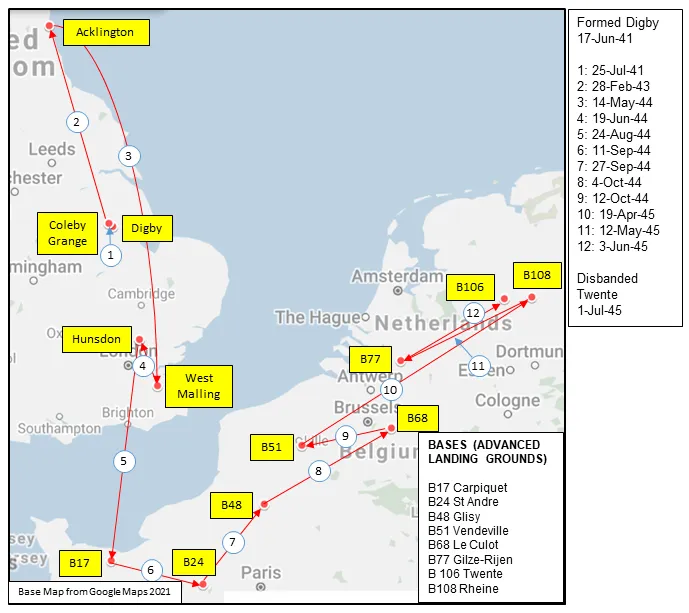
409 Squadron History Summary 1941-45
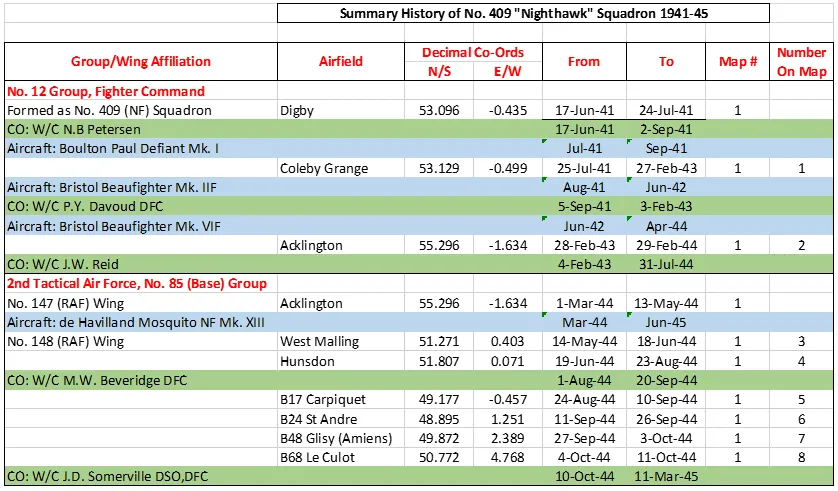
408 Squadron History Summary 1941-45 Page 2

History of the Squadron Post-WWII (Aircraft: CF-100, Voodoo, CF-18 Hornet)
The squadron was re-established at RCAF Station Comox, British Columbia ![]() on 1 November 1954 to provide air defence for Canada's west coast as part of NORAD. Initially equipped with the Canadian designed Avro CF-100 they converted to the CF-101 Voodoo in 1962. The squadron transferred to CFB Cold Lake in 1984 to convert to the CF-18 and then deployed to CFB Baden-Soellingen, Germany
on 1 November 1954 to provide air defence for Canada's west coast as part of NORAD. Initially equipped with the Canadian designed Avro CF-100 they converted to the CF-101 Voodoo in 1962. The squadron transferred to CFB Cold Lake in 1984 to convert to the CF-18 and then deployed to CFB Baden-Soellingen, Germany ![]() as part of Canada's NATO commitment. In October 1990, the squadron was deployed to the Persian Gulf, becoming the first Canadian squadron to see active service since WWII. Tasked with air defence of the allied fleet in the Persian Gulf, the squadron flew operational sorties immediately on arrival at Desert Home (Canada Dry 1 and 2) in Doha, Qatar. While on active duty, the squadron flew over 100 hours in the Middle East without any flight safety incidents. The squadron was then disbanded in 1991 with the withdrawal of Canadian Forces from Europe.
as part of Canada's NATO commitment. In October 1990, the squadron was deployed to the Persian Gulf, becoming the first Canadian squadron to see active service since WWII. Tasked with air defence of the allied fleet in the Persian Gulf, the squadron flew operational sorties immediately on arrival at Desert Home (Canada Dry 1 and 2) in Doha, Qatar. While on active duty, the squadron flew over 100 hours in the Middle East without any flight safety incidents. The squadron was then disbanded in 1991 with the withdrawal of Canadian Forces from Europe.
The squadron was briefly reformed back at Comox as a Combat Support Squadron (without aircraft) but was disbanded again.
409 Tactical Fighter Squadron was re-formed by the consolidation of 416 and 441 Tactical Fighter Squadrons on 6 July 2006 at CFB Cold Lake, Alberta ![]() . On 30 June 2015, personnel and equipment from 409 Tac F Sqn were reassigned to 401 Tac F Sqn, one of two Tac F Sqns within the Royal Canadian Air Force which were stood back up. The squadron complements the duties of 401 Tac F Sqn and, assisted by 410 Tactical Fighter (Operational Training) Squadron, deploys tactical fighter forces to meet Canadian and allied defence needs. Under the umbrella of the NORAD mission, fighter crews are on stand-by 24/7, ready to respond to any aerospace threat. The squadron is now one of two operational CF-18 Squadrons at 4 Wing Cold Lake.
. On 30 June 2015, personnel and equipment from 409 Tac F Sqn were reassigned to 401 Tac F Sqn, one of two Tac F Sqns within the Royal Canadian Air Force which were stood back up. The squadron complements the duties of 401 Tac F Sqn and, assisted by 410 Tactical Fighter (Operational Training) Squadron, deploys tactical fighter forces to meet Canadian and allied defence needs. Under the umbrella of the NORAD mission, fighter crews are on stand-by 24/7, ready to respond to any aerospace threat. The squadron is now one of two operational CF-18 Squadrons at 4 Wing Cold Lake.